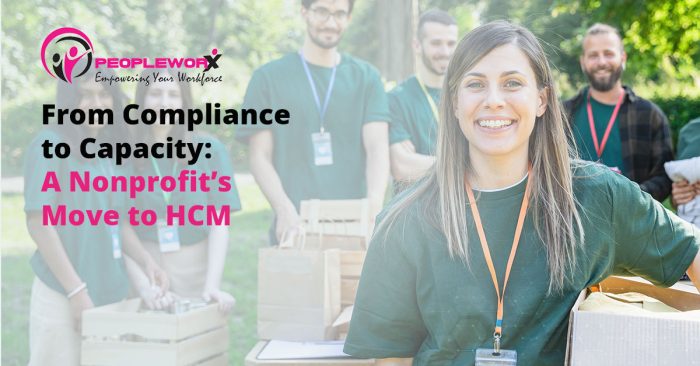In Part 3 of our series (check out the 2nd one here), we turn to a growing community-based nonprofit facing increasingly complex grant reporting, payroll allocation, and strategic workforce planning needs. Already equipped with HRIS and HRMS capabilities, the organization adopted a Human Capital Management (HCM) platform to connect HR, finance, and program operations. This post explores how HCM tools empower nonprofits to align people and performance with funding outcomes, turning compliance into capacity and data into mission-driven strategy.
Content
- A Growing, Community-Based Nonprofit: An HCM Case Study
- Recognizing the Strategic Need for Human Capital Management
- What is HCM and What Functions Does It Perform?
- Choosing the Right HCM Platform
- The HCM Implementation Process
- Educating Employees on HCM Adoption
- Unlocking Better Reporting and Grant Compliance
- Results After 6 Months of HCM Implementation
- Looking Ahead
A Growing, Community-Based Nonprofit: An HCM Case Study
For many community-based nonprofits, growth doesn’t just come from revenue, it comes from grants, programs, and impact expansion. And with that growth comes greater complexity: multi-source funding, program-specific payroll, donor reporting, and staff management across multiple job codes and locations.
This was the reality for one mid-sized nonprofit focused on youth development and family support services. With over 100 employees working across after-school programs, counseling centers, and community outreach initiatives, they found themselves juggling spreadsheets, separate systems, and ever-tightening compliance demands.
They had already implemented an HRIS to centralize employee records and payroll, then added HRMS capabilities for recruiting, onboarding, and training. But as funding sources expanded and board members pushed for more strategic reporting, it became clear: they needed an HCM platform that could tie workforce strategy to organizational goals and support deep financial and operational oversight.

Recognizing the Strategic Need for Human Capital Management
The nonprofit had recently received a multi-year federal grant tied to very specific program objectives and equally specific payroll and reporting expectations. Their current systems couldn’t:
- Track staff time across multiple programs or funding sources
- Allocate wages proportionally based on work performed
- Provide real-time labor cost insights across grants
- Offer workforce analytics to support planning and sustainability reporting
Department heads were frustrated. Finance staff spent days assembling quarterly grant reports. HR had no clear visibility into turnover trends or leadership development. The systems in place were reactive but the organization was being asked to be proactive.
What is an HCM System and What Functions Does It Perform?
A Human Capital Management (HCM) platform combines the operational tools of an HRIS and HRMS with strategic capabilities like workforce planning, analytics, talent management, and financial alignment. It enables organizations to see how workforce performance, payroll, and compliance intersect with long-term goals.
For nonprofits, the most valuable HCM features often include:
- Advanced Labor Allocation & Job Costing: Assign labor costs to specific grants, programs, and locations, with automated payroll feeds.
- Integrated Budgeting & Forecasting Tools: Plan workforce needs based on funding cycles, capacity goals, and organizational benchmarks.
- Workforce Analytics: Track turnover, tenure, compensation trends, and staff development across departments or programs.
- Succession & Leadership Planning: Identify future leaders, assign development plans, and retain institutional knowledge.
- Engagement & Culture Tools: Deploy pulse surveys, gather feedback, and reinforce mission alignment across diverse teams.
- Integrated Payroll, HR, and Reporting: Eliminate data silos between departments, so HR, Finance, and Program teams can align on staffing decisions.
An HCM platform goes beyond compliance, it turns workforce data into a strategic asset.
Choosing the Right HCM Platform
Working with PeopleWorX, the nonprofit conducted a cross-functional needs assessment. They involved HR, Finance, Program Directors, and the Executive Director to define:
- Reporting and compliance gaps
- Strategic workforce goals (including leadership development and retention)
- Operational needs for payroll allocation and grant tracking
PeopleWorX recommended a scalable HCM platform that would:
- Automate payroll allocations by grant, location, and department
- Generate board-ready reports with real-time labor metrics
- Provide dashboards for leadership development and performance tracking
- Integrate employee engagement tools to support retention
- Offer audit-ready tools to simplify federal and state reporting
Crucially, it also connected HR and payroll with financial systems, ensuring consistent, accurate reporting for grant compliance and internal accountability.
The HCM Implementation Process
Implementation was phased over six months, with PeopleWorX providing project management and ongoing support.
- Phase 1: Labor allocation setup, payroll automation, and integration with accounting
- Phase 2: Rollout of engagement, performance tracking, and workforce dashboards
- Phase 3: Strategic planning tools, succession mapping, and leadership training tracking
The organization designated team leads in Finance and HR, and PeopleWorX provided hands-on onboarding, cross-departmental training, and a dedicated consultant to ensure grant compliance workflows were properly configured.

Educating Employees on HCM Adoption
Educating the team included hands-on training in the HCM software itself and workshops aimed at changing how departments collaborate. HR and Finance staff were trained together, with joint working sessions to build custom reports and dashboards for board and grant stakeholders.
Program managers received role-based access to view team metrics, track training, and monitor engagement without accessing sensitive payroll data. Employees gained access to a self-service portal where they could:
- Track hours across different programs or funding streams
- Access feedback and development plans
- Update personal info and view pay stubs
- Participate in organization-wide surveys
In addition, the nonprofit’s team had a direct line to a PeopleWorX HR expert dedicated to their implementation for real-time issue resolution during rollout.
Unlocking Better Reporting and Grant Compliance
One of the most impactful outcomes was the nonprofit’s ability to meet complex grant reporting requirements without scrambling at the end of each quarter. With the new HCM platform, they could:
- Generate payroll-based grant reports by program, with clean audit trails
- Track funding-specific performance metrics (e.g., staff-to-client ratios, cost per hour)
- Ensure 100% of staff had up-to-date training and certifications linked to funding terms
- Build dashboards for internal and board-level visibility into HR trends and workforce capacity
As a result, the organization saw faster reimbursements, stronger audit readiness, and better collaboration between departments.
Results After 6 Months of HCM Implementation
Within half a year of implementation, the nonprofit saw:
- 80% reduction in time spent preparing payroll-based grant reports
- A 25% improvement in staff retention across three core programs
- Real-time visibility into workforce trends and turnover
- A culture shift toward leadership development and employee engagement
- Increased confidence among board members and funders around compliance and sustainability

Looking Ahead
With the HCM system fully operational, the organization is planning to deepen its analytics use, explore compensation modeling, and expand succession planning across its leadership tiers.
What began as a tactical compliance need has evolved into a strategic shift in workforce thinking and a more unified view of how people drive the mission.
For nonprofits, workforce management is mission-critical. An HCM platform empowers organizations to align people, funding, and strategy, making it easier to increase community impact without growing operational chaos.






